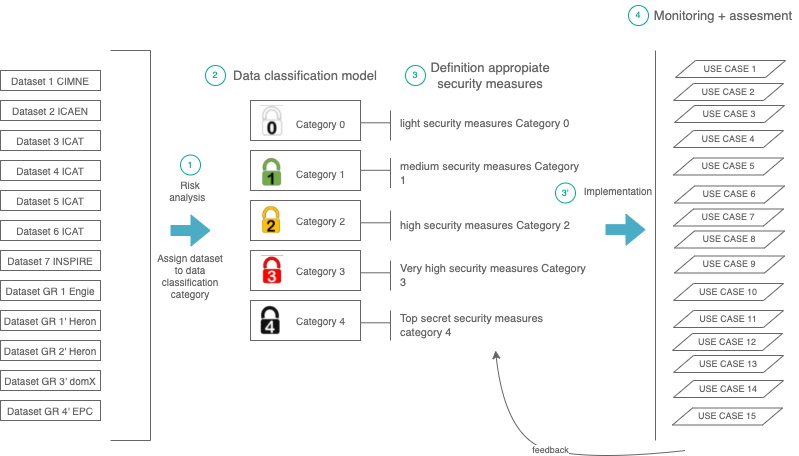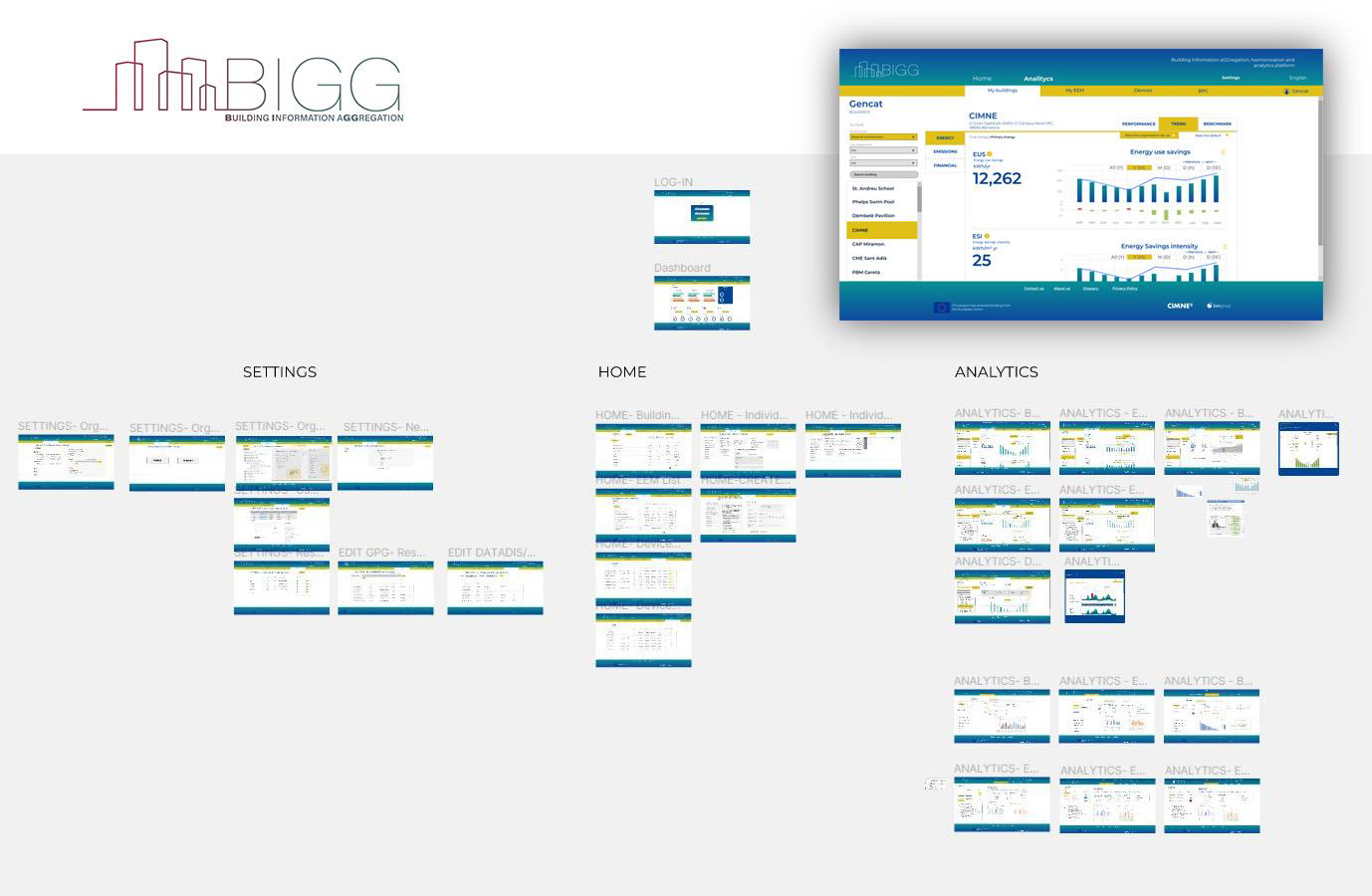Throughout the May Newsletter, BIGG presents the recent progress of the project and the most remarkable activities carried out and gives an overview of related events.
Data Reference Architecture
The central result of BIGG is to develop a technical platform able to aggregate and harmonise the data from different sources (smart meters, sensors, BMS, existing data sets) and to provide a toolbox to perform analytics on these data.
The BIGG platform relies on the BIGG Data Reference Architecture 4 Buildings which has been initiated during the first period of the project. The methodology adopted to define the services and the supporting architecture of the platform has followed the steps below:
- A set of services has been defined from a first expression of Business cases refined in Use by the Pilot’s owner in the consortium. During this phase a formal standard (BPMN) has been used to ease the comparison/aggregation among use cases.
- Based on the results obtained (first set of services) an initial version of the BIGG Data Reference Architecture has been designed.
The first samples of code implementing the BIGG Data Reference Architecture have been produced and the project has entered in its first integration round.
End-users communication and security layers
To communicate between the BIGG components and the end-user applications that will eventually use BIGG components we are developing a communication layer. The communication layer was depicted as “responsible for developing the necessary components to ingest and expose all types of building data”. Regarding the state-of-the-art reference architecture framework (RAF) which has been designed by the BIGG team.
In short, the communication layer provides a generic way to accept data into the BIGG platform. It does this by accepting multiple widely used protocols for data transfer. We also provide a starting point for developing a custom data ingestor for when the generic ones don’t suffice.
Some of the data ingested into the BIGG Platform will be confidential data. To make sure that data is handled with the necessary precautions we are building a security guideline for partners that want to use BIGG. The team is building this set of guidelines by assessing all types of data that are coming in, categorizing those datasets according to several risk factors. Once a dataset falls into a certain category, we can provide a set of guidelines and best practices to make sure the data is handled in a correct way.

Data harmonization layer
During the first period of the project, the harmonisation of the building data for the BIGG platform has been developed. The challenge has been to import data from multiple sources and harmonise them within the ontology base of the project’s data model. This process has taken our full attention given the heterogeneity of the building data such as energy consumption, occupancy patterns, building energy efficiency measures, or intrinsic data such as floor area, number of floors or year of construction.
The researchers have done methodical work with different tools of the linked data driven frameworks to match the different data sources, creating a single data source with all the information. The result is a data model with a robust structure for the back-end of the platform.
The BIGG platform
We started building the back-end of the BIGG platform in early 2022 to integrate the different harmonisation layers, and at the same time we worked on the visualisation of the front-end through mockups to obtain a User Interface (UI) and User eXperience (UX) with all the initial requirements and that meets to the use cases and business cases of all the pilots.
At the moment, we are finishing adapting the different visualisations to the requirements, in order to continue with the final phase of the front-end production and have the platform ready for testing during the next months.

An Artificial Intelligence toolbox tailored to the needs of energy management companies
The BIGG project is assessing the potential of big data for building energy efficiency enhancement. Through 6 business cases addressing most of the common challenges faced by the energy efficiency industry, the project aims at providing a solution kit to enable data analytics to increase European buildings level of performance.
As part of this solution kit, the BIGG consortium is working on the design of an AI toolbox to provide energy manager and energy analysts with a set of AI functions developed specifically for the fulfilment of these business cases. After the project crossed the one-year line, the AI toolbox is now entering the implementation phase.
With a specific focus on the needs of the identified business cases, the BIGG AI toolbox is proposing a set of functions enabling existing platforms to push their analytics capabilities.
The functions developed are articulated across 4 main sections.
The preliminary version of the toolbox is now finalized and the project is entering the implementation phase where available functions are being combined and organized into pipelines tailored to answer the specific needs of each business cases. As the project progresses, the pipelines will be packaged and made accessible directly via the BIGG platform.
Fully integrated in the BIGG architecture, the AI toolbox is leveraging the BIGG harmonized data format allowing to simplify the necessary steps of data understanding and data preparation. Although the planned AI toolbox is expected to be delivered as a fully packaged solution for the industry, the core components of the AI toolbox will be fully accessible to enable every stakeholder to assemble the components to best fit its own use. The functions are developed in both R and Python for maximum compatibility with existing platforms.
First results of the AI toolbox implementation are expected by the end of the month.
BIGG related news
Sustainable Places: 6th – 9th September 2022, Nice (France)
Renowned for showcasing results coming out of the EU Horizon 2020 Framework Programme via the participation of cutting-edge research and innovation projects, the scope of Sustainable Places is captured directly in its name. It involves designing, building and retrofitting the places we live and work in a more sustainable way. SP is a platform for the dissemination of research, the conduct of workshops, EU project clustering and networking between stakeholders of all types.
EU Sustainable Energy Week (EUSEW): 26th – 30th September 2022, Brussels (Belgium)
This year, the EU Sustainable Energy Week (EUSEW) will return in a new hybrid format, with both participants and speakers able to participate onsite and online. The event will comprise a high-level Policy Conference, the EUSEW Awards, and the third European Youth Energy Day as well as opportunities for 1:1 meetings, exhibition stands and other networking activities. BIGG has submitted a joint application with the sister projects BuiltHub, BEYOND and MATRYCS. The session would be focused on the “what, how and why” of big building data collection in Europe, shining a spotlight on three aspects big data for effectively transforming the EU’s building stock towards higher energy efficiency cost-effectively and achieving climate neutrality.




